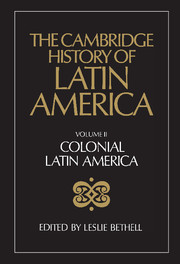Book contents
- Frontmatter
- PART ONE POPULATION
- PART TWO ECONOMIC AND SOCIAL STRUCTURES: SPANISH AMERICA
- 3 The urban development of colonial Spanish America
- 4 Mining in colonial Spanish America
- 5 The formation and economic structure of the hacienda in New Spain
- 6 The rural economy and society of colonial Spanish South America
- 7 Aspects of the internal economy of colonial Spanish America: labour; taxation; distribution and exchange
- 8 Social organization and social change in colonial Spanish America
- 9 Women in Spanish American colonial society
- 10 Africans in Spanish American colonial society
- 11 Indian societies under Spanish rule
- PART THREE ECONOMIC AND SOCIAL STRUCTURES: BRAZIL
- PART FOUR INTELLECTUAL AND CULTURAL LIFE
- Bibliographical essays
5 - The formation and economic structure of the hacienda in New Spain
from PART TWO - ECONOMIC AND SOCIAL STRUCTURES: SPANISH AMERICA
Published online by Cambridge University Press: 28 March 2008
- Frontmatter
- PART ONE POPULATION
- PART TWO ECONOMIC AND SOCIAL STRUCTURES: SPANISH AMERICA
- 3 The urban development of colonial Spanish America
- 4 Mining in colonial Spanish America
- 5 The formation and economic structure of the hacienda in New Spain
- 6 The rural economy and society of colonial Spanish South America
- 7 Aspects of the internal economy of colonial Spanish America: labour; taxation; distribution and exchange
- 8 Social organization and social change in colonial Spanish America
- 9 Women in Spanish American colonial society
- 10 Africans in Spanish American colonial society
- 11 Indian societies under Spanish rule
- PART THREE ECONOMIC AND SOCIAL STRUCTURES: BRAZIL
- PART FOUR INTELLECTUAL AND CULTURAL LIFE
- Bibliographical essays
Summary
ECONOMIC TRANSFORMATION
The first revolution to transform the land in Mesoamerica was the invention in prehistoric times of agriculture itself. The second revolution took place some decades after the conquest, when the brutal decline in the native American population coincided with the Spaniards’ penetration of the land and the propagation there of European plants and animals. The swiftness with which this process occurred may perhaps be explained by the previous acclimatization of European flora and fauna in the Canary Islands and the Caribbean. The mainland itself offered many different ecological zones for the reproduction of plants and animals. As early as the middle of the sixteenth century, the valleys of Puebla–Tlaxcala and the basin around Mexico City surprised the traveller with their diversified agricultural landscape, where maize, beans, squash, and peppers alternated with wheat, barley, and European vegetables and fruits.
European grain spread to the irrigated highlands south of Puebla (Atlixco, Tepeaca) and north of Mexico City (Tlalnepantla and Huehuetoca), and then on from there, pushing back the Chichimeca frontier (San Juan del Río, Querétaro). By the end of the sixteenth century, wheat and maize gilded the black soil of the Bajío and were harvested around Morelia and Guadalajara in the west and Oaxaca in the south. Within a relatively short period of time grain transformed the traditional landscape of the native countryside, opening up many hundreds of kilometres of fertile land to cultivation. Wheat farming introduced Spanish techniques of cultivation, such as the plough, the yoke, and irrigation, bringing them into permanent use in New Spain.
- Type
- Chapter
- Information
- The Cambridge History of Latin America , pp. 153 - 188Publisher: Cambridge University PressPrint publication year: 1984
- 6
- Cited by



